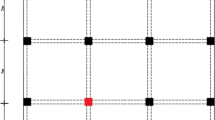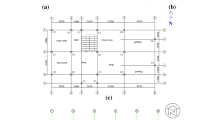Abstract
Past earthquakes demonstrate that most significant part of losses in buildings are due to the poor seismic performance of substandard reinforced concrete (RC) buildings. It is necessary to retrofit substandard buildings to reduce/prevent casualties and economic losses. Two of the most widely preferred conventional seismic retrofit approaches are the integration of new structural walls and/or RC jacketing of existing RC columns. This paper presents an attempt for comparison of the effectiveness of these conventional seismic retrofitting methods for substandard RC buildings. For this purpose, an existing four-story RC moment frame building is considered as a case study. The building represents typical substandard RC frame buildings common in Türkiye. After conducting a seismic assessment of the building according to Turkish Building Earthquake Code-2018 (TBEC-2018) and demonstrating its unsatisfactory performance, a retrofit design is made to satisfy the target seismic performance level (controlled damage-life safety) specified in TBEC-2018. Then, a series of nonlinear structural analyses were performed by using Incremental Dynamic Analysis (IDA) technique for the original state of the building (before retrofitting) and for the seismically retrofitted states, Peak Ground Acceleration (PGA) based fragility curves were obtained for each state. Furthermore, based on the obtained fragility curves and making use of new construction, repair and retrofitting costs, cost-benefit analyses were conducted to compare the original state of the building and the two retrofitted states. The results of the fragility and cost-benefit analyses indicate that seismic retrofitting of such buildings by integration of new shear walls or column jacketing provided a remarkable improvement in both seismic performance and loss reduction, compared to the original state of the building. The relevant quantitative comparisons, which may be critical for seismic mitigation decisions are also presented. Finally, it was also shown that the value assumed for human life in the calculations has a remarkable impact on the expected loss.
Access this chapter
Tax calculation will be finalised at checkout
Purchases are for personal use only
Similar content being viewed by others
References
Ilki A, Celep Z (2012) Earthquakes, existing buildings and seismic design codes in Turkey. Arab J Sci Eng 37:365–380
Tapan M, Comert M, Demir C, Sayan Y, Orakcal K, Ilki A (2013) Failures of structures during the October 23, 2011 Tabanlı (Van) and November 9, 2011 Edremit (Van) earthquakes in Turkey. Eng Fail Anal 34:606–628
Gurbuz T, Cengiz A, Kolemenoglu S, Demir C, Ilki A (2022) Damages and failures of structures in Izmir (Turkey) during the October 30, 2020 Aegean Sea earthquake. J Earthquake Eng:1–42
Cakti E, Safak E, Hancilar U, Sesetyan K (2019) Updating Probable Earthquake Loss Estimates for Istanbul Province. Technical report prepared for Istanbul Metropolitan Municipality
Demir C, Comert M, Aydogdu HH, Ilki A (2022 August). Seismic Risk Assessment and Preliminary Intervention Cost-Benefit Analysis for the Building Stock of Istanbul. In Progresses in European Earthquake Engineering and Seismology: Third European Conference on Earthquake Engineering and Seismology–Bucharest, 2022, Springer, Cham, pp 212–224
Cosgun C, Cömert M, Demir C, İlki A (2019) Seismic retrofit of joints of a full-scale 3D reinforced concrete frame with FRP composites. J Compos Constr 23(2):04019004
Farrokh Ghatte H, Comert M, Demir C, Akbaba M, Ilki A (2019) Seismic retrofit of full-scale substandard extended rectangular RC columns through CFRP jacketing: Test results and design recommendations. Journal of Composites for Construction, 23(1), 04018071
Smyth AW et al (2004) Probabilistic benefit-cost analysis for earthquake damage mitigation: Evaluating measures for apartment houses in Turkey. Earthq Spectra 20(1):171–203
Liel AB, Deierlein GG (2013) Cost-benefit evaluation of seismic risk mitigation alternatives for older concrete frame buildings. Earthq Spectra 29(4):1391–1411
Cardone D, Flora A, Manganelli B (2014) Cost-benefit analysis of different retrofit strategies following a displacement-based loss assessment approach: a case study. In: Tenth US national conference on earthquake engineering, pp 21–25
Yazgan U, İlki A, Demir C, Demir U, Ateş AO, Küpçü E, ... & Narlıtepe F (2019) Challenges in developing seismic vulnerability models for substandard building stocks in Turkey. In 2nd international workshop on advanced materials and innovative systems in structural engineering: novel researches, p 112
Disaster and Emergency Management Presidency: Turkish Building Earthquake Code (2018). Ankara, Türkiye
CSI (2013) PERFORM-3D. Computers and Structures, Inc., Berkeley
Scott BD, Park R, Priestley MJ (1982) Stress-strain behavior of concrete confined by overlapping hoops at low and high strain rates. J Proc 79(1):13–27
Yalcin C, Saatcioglu M (2000) Inelastic analysis of reinforced concrete columns. Comput Struct 77(5):539–555
Mau ST, El-Mabsout M (1989) Inelastic buckling of reinforcing bars. J Eng Mech 115(1):1–17
Danciu L et al (2021) The 2020 update of the European seismic hazard model: model overview. EFEHR Tech Rep 1:v1
Ministry of Environment, Urbanization, Climate Change: Construction Unit Prices (2022). Ankara, Türkiye
Mitrani-Reiser J (2007) An ounce of prevention: probabilistic loss estimation for performance-based earthquake engineering (Doctoral dissertation, California Institute of Technology)
Federal Emergency Management Agency (FEMA) (1999) Earthquake Loss Estimation Methodology HAZUS99 Service Release 2 (SR2) Technical Manual, Washington D.C., U.S.A
Bal İE, Crowley H, Pinho R, Gülay FG (2008) Detailed assessment of structural characteristics of Turkish RC building stock for loss assessment models. Soil Dyn Earthq Eng 28(10–11):914–932
Di Ludovico M, De Martino G, Prota A, Manfredi G, Dolce M (2021) Damage assessment in Italy, and experiences after recent earthquakes on reparability and repair costs. Advances in Assessment and Modeling of Earthquake Loss, 65
Acknowledgements
This research has been funded by the Scientific and Technological Research Council of Türkiye (TUBITAK) under the grant number 216M379 and Research Councils UK (RCUK) under the grant number EP/P010016/1. The authors would like to thank to Ali Osman Ates, Busranur Karakaya, Eren Kupcu for their contributions.
Author information
Authors and Affiliations
Corresponding author
Editor information
Editors and Affiliations
Rights and permissions
Copyright information
© 2023 The Author(s), under exclusive license to Springer Nature Switzerland AG
About this paper
Cite this paper
Altinok, M.A., Unal, G., Demir, C., Yazgan, U., Ilki, A. (2023). Effect of Conventional Retrofitting Methods on the Seismic Fragility of Substandard RC Buildings: A Cost-Benefit Analysis. In: Ilki, A., Çavunt, D., Çavunt, Y.S. (eds) Building for the Future: Durable, Sustainable, Resilient. fib Symposium 2023. Lecture Notes in Civil Engineering, vol 350. Springer, Cham. https://doi.org/10.1007/978-3-031-32511-3_97
Download citation
DOI: https://doi.org/10.1007/978-3-031-32511-3_97
Published:
Publisher Name: Springer, Cham
Print ISBN: 978-3-031-32510-6
Online ISBN: 978-3-031-32511-3
eBook Packages: EngineeringEngineering (R0)




